We have much more to do and your continued support is needed now more than ever.
Meet the Stars of the Newest Reality Series on TV—North America
 Forget Usher and Shakira, the newest reality TV stars can be found on Animal Planet starting Tuesday, May 28, at 9 p.m. EDT. That’s when viewers will be introduced to the cast of NORTH AMERICA, a new series featuring some of the continent’s most spectacular wildlife: everything from massive grizzly bears to newly hatched sea turtles.
Forget Usher and Shakira, the newest reality TV stars can be found on Animal Planet starting Tuesday, May 28, at 9 p.m. EDT. That’s when viewers will be introduced to the cast of NORTH AMERICA, a new series featuring some of the continent’s most spectacular wildlife: everything from massive grizzly bears to newly hatched sea turtles.
These animal “celebrities” face a daily struggle to survive in the most dangerous places in the world. They also hold a special place in our hearts here at National Wildlife Federation because they are the animals we work hard to protect.
>> Watch clips from NORTH AMERICA
Read our report on what stars we expect will steal the show…
Mountain Goat
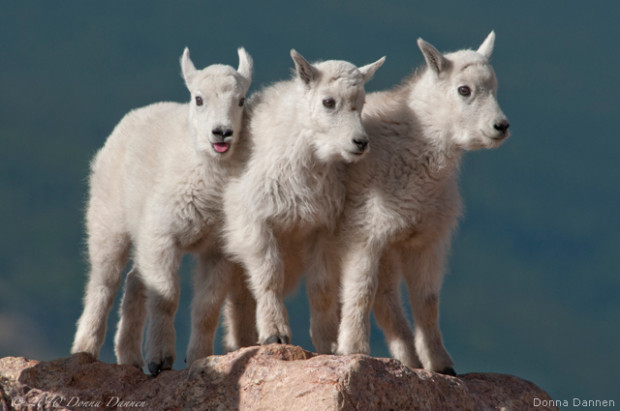
Hometown: Native to Alaska and British Columbia.
Locale: Now living throughout the Rocky Mountains, including Colorado, Utah and Nevada.
Unusual Characteristics? This actor is literally thick-skinned: up to an inch in places.
Fun Fact: Adult mountain goats average three to four conflicts (of varying degree) per hour with other goats.
Favorite Things: Salt licks; low-hanging branches (when spooked, mountain goats will sometimes climb into trees).
M&Ms in the Green Room? Mountain goats subsist on scarce mountain grasses, ferns, herbs and other plants.
Hostile Work Environment: Avalanches, sonic booms, cougars, golden eagles.
Favorite Hot Spots: The most inaccessible crags in the Western Hemisphere; Olympic National Park.
Mountain goats are among North America’s most isolated creatures. Traveling above the tree line, these acrobats begin climbing mere hours after being born. Your next reality show will be full of confrontation if you cast mountain goats — like alpine Real Housewives, nannies are notoriously aggressive, bickering over the finest inhospitable ledges while their kids form play groups. They’re also great for stunt work, rarely falling and recovering quickly when they do.
Latest Gossip
Mountain goats aren’t facing the same conservation problems as other species in this list. However, they do serve as a reminder of why native habitat is crucial for wildlife. When introduced into Olympic National Park, mountain goats quickly disrupted the ecological equilibrium by devouring native plants. About 700 were removed from the park, and efforts are underway to manage those goats remaining within the park boundaries.
Kemp’s Ridley Sea Turtle
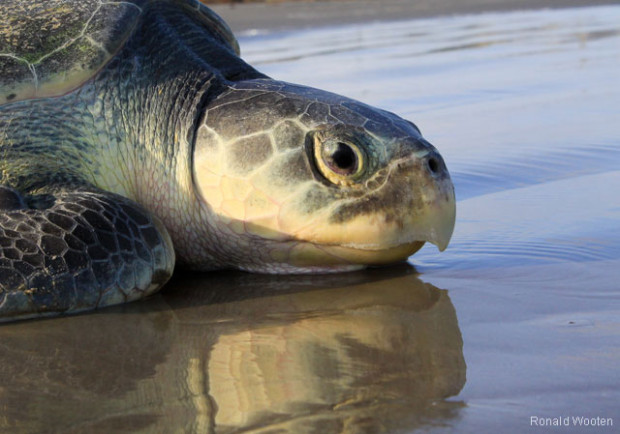
Hometown: Tamaulipas, Mexico
Locale: This Southern Belle prefers the Louisiana waters of the Northern Gulf of Mexico.
Fun Fact: Female Kemp’s ridleys return to nest on the same beach where they were hatched.
Favorite Things: Beaches backed by swampland, responsible fishermen.
M&Ms in the Green Room? Kemp’s ridleys prefer swimming crabs, but will settle for fish, jellyfish and mollusks.
Hostile Work Environments: Developed beachfront, oil spills.
Favorite Hot Spots: They prefer the muddy bottoms of nearshore waters, where prey can be easily found.
Most notable role: Some 42,000 Kemp’s ridleys starred in an amateur film in 1947.
Kemp’s ridley sea turtles are the smallest marine turtles in the world, and the vast majority nest in one area near Tamaulipas, Mexico. If you’re looking for the next teen star, try some other species: these sea turtles spend their formative years in the open ocean. Males will sometimes range far and wide looking for food before returning to mate.
Latest Gossip
Sea turtles face enormous obstacles toward replenishing their numbers. Protection of beach nesting sites (especially in Mexico) has led to great strides in recovery of the species, though bycatch (accidental capture in shrimp trawls, gill nets, longlines and dredges) is still the largest problem these species face. Efforts to use modified fishing equipment is helping reduce the incidence of bycatch.
Help wildlife like sea turtles today with a symbolic adoption!
Burrowing Owl
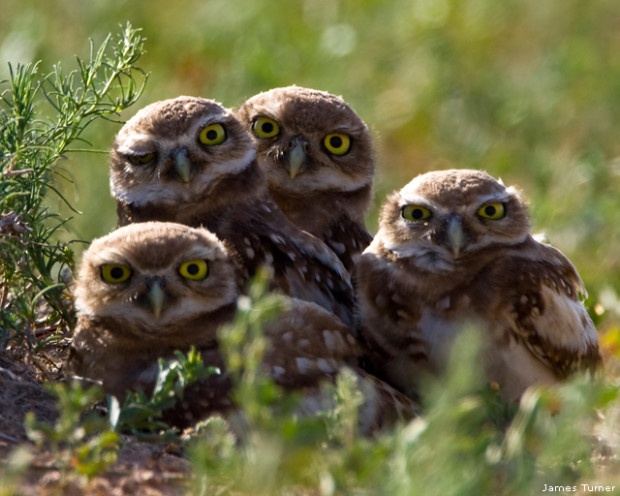
Hometown: Locale: In North America, range is from Southwestern Canada during the summer to Mexico in the winter.
Fun Fact: Burrowing owls collect mammal waste to attract dung beetles.
Favorite Things: Couch-surfing (it often lives in burrows dug by other animals).
M&Ms in the Green Room? Dung beetles are the owls’ favorite delicacy.
Hostile Work Environment: Highways, development, coyotes.
Favorite Hot Spots: Burrows of the various species of prairie dogs, golf courses.
Burrowing owls are attentive parents, remaining with their young for 40 days until the owlets are ready to leave the nest. The owlets are natural actors — they remain behind while their parents hunt, mimicking the sounds or rattlesnakes to scare off predators.
Latest Gossip
Burrowing owls are able to dig their own nests underground, but often use those excavated by mammals like prairie dogs. Prairie dogs, in turn, are in decline due to habitat loss, leaving fewer ready nesting sites available for burrowing owls. There’s a real conservation concern due to pesticide use, which impacts the owls’ food supply.
The biggest threat to these birds, however, is automobile collisions. Burrowing owls can hunt on the wing, but also do so by hopping or running along the ground, a practice that makes them susceptible to car strikes.
Bison
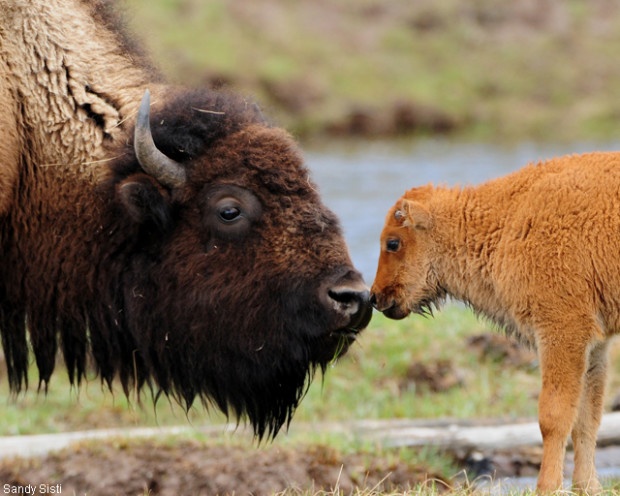
Hometown: The last wild bison in the U.S. were once confined to Yellowstone National Park.
Locale: Montana’s Great Plains
Fun Fact: Bison can grow to more than 6 feet in height, with males weighing more than 2 tons.
Favorite Things: The National Park system.
M&Ms in the Green Room? Bison prefer low growing grasses and sedges.
Hostile Work Environment: Winter, grizzly bears, wolves.
Favorite Hot Spots: Charles M. Russell National Wildlife Refuge and Tribal Lands including Fort Peck and Fort Belknap.
Most notable role: Bison played a pivotal role in Dances with Wolves.
Bison are the quintessential animal of North American prairies. Once numbering more than 40 million strong, the continent’s largest terrestrial animal was nearly hunted to extinction. Bison will likely work best as extras, since they communicate mostly via smell and pheromones (though they do grunt, snort and growl).
Latest Gossip
Our decimation of bison in the late 19th Century is one the most tragic stories of a species’ decline, but the restoration of these majestic mammals may be even more compelling. National Wildlife Federation is working to return wild, free-ranging bison to their native homes. Working with ranchers who own lands near a wildlife refuge, and with tribal partners on reservations, we hope bison will soon return to their native prairies.
There are still obstacles in the way, mainly political — thanks to popular support our partners in Montana were recently able to thwart several pieces of legislation that would have negatively impacted bison there.
Sandhill Crane
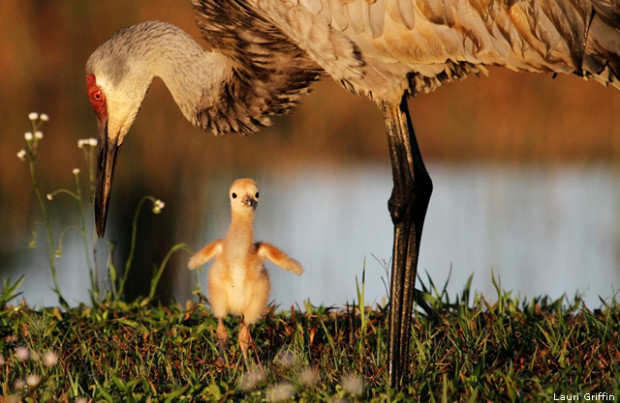
Hometown: Nebraska’s Platte River valley.
Locale: Three subpopulations are migratory, while three others remain in their habitats in Florida, Mississippi and Cuba.
Fun Fact: To the spa! Sandhill cranes preen themselves by rubbing mud on their feathers.
Favorite Things: Wet pine savannah.
M&Ms in the Green Room? Cranes mostly eat grains and plants, but will also eat small mammals, amphibians and reptiles.
Hostile Work Environment: Interstate Highways, red tailed hawks, bobcats.
Favorite Hot Spots: Mississippi Sandhill Crane National Wildlife Refuge.
Sandhill cranes are a double threat: they sing and dance. They are the perfect star for your next romantic musical, as sandhill cranes will form lifelong pair bonds, dancing throughout mating season while joining in a unison call of singing.
Latest Gossip
The Mississippi subspecies is a clear example of waiting too late to begin the conservation process. While Mississipi sandhill cranes were saved from extinction (though are still critically endangered), experts say they’ll need constant management: work to repair and restore habitat, reduce predation and release cranes raised in captivity to replenish population loss. In addition, sandhill cranes in general are facing the same issue as many other species: loss of wetlands and their other preferred habitats.
Help NWF protect wildlife — Donate Today>>
Pronghorn
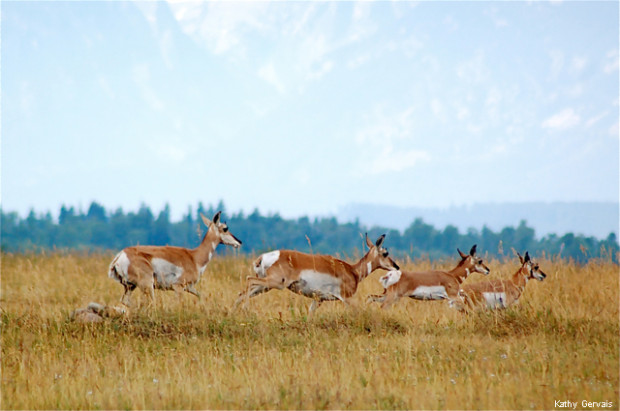
Locale: Mainly found in the Great Plains, with some populations in Oregon, Nevada, Utah, Colorado, Arizona and New Mexico.
Fun Fact: A pronghorn could beat a human marathon runner even if the human had an 18-mile headstart.
Favorite Things: Wildlife corridors.
M&Ms in the Green Room? No bottled water—pronghorn get most of their water from food, which includes grasses, forbs, succulents and cacti.
Hostile Work Environment: Fences, highways, long-extinct American cheetahs.
Favorite Hot Spots: Red Desert and Yellowstone.
Pronghorn might be your next action star: they sprint at 60 mph. Scientists believe the species developed their unique combination of speed and stamina to out-maneuver prehistoric predators that are now extinct. While adults no longer have any natural predators, young pronghorn have a 50% mortality rate in the wild due to predation from coyotes, bobcats and golden eagles.
Latest Gossip
Nationally, pronghorn are thriving across much of their native habitat. While their young are under constant threat from predators, the species seems to have adapted by rearing twin fawns each year. It’s not all blue skies and open prairies, however. The biggest obstacle for pronghorn is the lowly fence—despite an ability to easily jump over fences (as deer often do), pronghorn refuse.
Roads and highways are additional obstacles, especially in the Southwest. While pronghorn make a 300-mile roundtrip between Wyoming’s Upper Green River Basin and Grand Teton National Park every year, endangered Sonoran pronghorn are boxed into a small area.
Ferruginous Hawk

Hometown: Native to North America
Locale: Open country of western North America (Canada, Great Plains, Mexico)
Fun Fact: Before the elimination of bison in the West, nests of the ferruginous hawk were often partially constructed of bison bones and wool.
Favorite Things: Warm air currents
M&Ms in the Green Room?: Sometimes referred to as “squirrel hawk” due to its fondness for ground squirrels. Rabbits and prairie dogs will also suffice.
Hostile Work Environment: Extreme heat in the summer plains.
Favorite Hot Spots: Find them year round in the open country of eastern Utah, Colorado, Arizona and New Mexico.
This is the breakout role for the largest American hawk. They take costume very seriously, and are covered head-to-toe in feathers. As unique vocalists, ferruginous hawks specialize in screechy squeals you may hear in horror films.
Gray Wolf
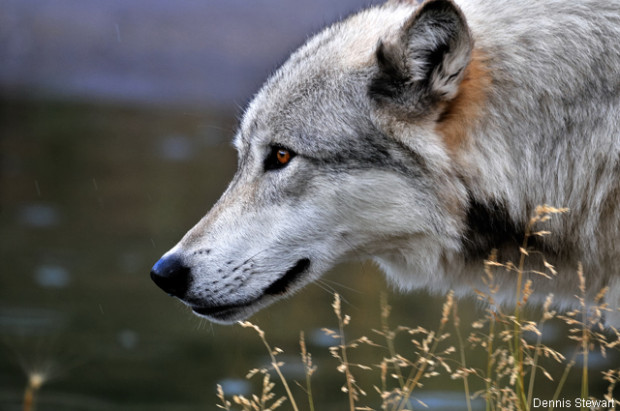
Locale: Stable populations exist in Alaska, and in the northern reaches of Michigan, Wisconsin and Montana, among other places.
Fun Fact: Wolves play a critical role in ecological biodiversity—once reintroduced to Yellowstone, other species returned as well.
Favorite Things: Certain apparel, Angry Birds.
M&Ms in the Green Room? Wolves prefer ungulates like moose, deer, elk and bison but will hunt just about anything.
Hostile Work Environment: Red Riding Hood, full moons.
Favorite Hot Spots: Like many of its costars, Yellowstone.
Most notable role: I’ve always been partial to Never Cry Wolf.
The wolves’ iconic howl serves as a way to bring a pack back together if spread over long distances, and as a warning to strangers. Not unlike the Bluths, gray wolves form familial packs with dominant male and female leaders.
After a long history of being seen as a threat, wolves are now known to be a critical part of healthy ecosystems in their native range.
Latest Gossip
Like bison, wolves have recovered in select pockets of their once vast native range. Their reintroduction into Yellowstone spurred a resurgence in biodiversity — aspens, beavers and red foxes have returned, while the runaway increase of coyotes and elk has been checked.
Unfortunately, in Canada, gray wolves have become a favorite scapegoat for declining caribou populations (see below). As a result, government-sanctioned efforts to “cull” the species include poison-laced bait and aerial hunts from helicopters.
Help wildlife like wolves today with a symbolic adoption!
Caribou
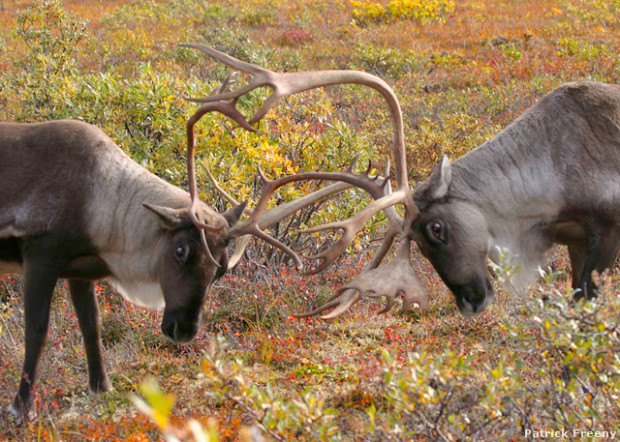
Locale:
Alpine and subalpine habitats, forests and woodlands.
Fun Fact:
Domesticated and semi-domesticated caribou are called reindeer.
M&Ms in the Green Room?
Vegetarian meals only, please. They enjoy eating the leaves of willows, flowering tundra plants, sedges and mushrooms.
Hostile Work Environment:
The Keystone XL pipeline threatens to encroach on this star’s key habitat. They can handle migrating far distances, but having a place to stay is vital.
Favorite Hot Spots:
They can be spotted in boreal forests and chilly environments.
Caribou conduct the longest migration of any terrestrial species in North America. Labrador, Canada, is home to the greatest migration of 28,000 caribou—they travel 3,700 miles each year.
Latest Gossip
Over the last 50 years, about half of caribou habitat has disappeared due to timber, oil and gas development in the heart of their range, leading to steep declines in populations. Now, the expansion of tar sands production is threatening to destroy what remains of their fragile habitat—and if development continues unchecked, scientists predict that some herds in the tar sands region could disappear in as little as 30 years. The situation has spiraled so far out of control that it’s prompted misguided plans by the Canadian government to “rescue” caribou by shooting hundreds of wolves.
NWF is working to protect caribou by stopping the expansion of the dangerous Keystone XL pipeline. Just this week, we helped thwart an attempt by pipeline supporters in Congress to push the project forward.
Do Your Part to Protect Wildlife
![]() The animals featured on NORTH AMERICA face myriad dangers in their everyday lives. Many of those dangers are natural, but our actions also impact these animals and their habitat. You can help protect wildlife, like these extraordinary species, by donating to the National Wildlife Federation.
The animals featured on NORTH AMERICA face myriad dangers in their everyday lives. Many of those dangers are natural, but our actions also impact these animals and their habitat. You can help protect wildlife, like these extraordinary species, by donating to the National Wildlife Federation.





















